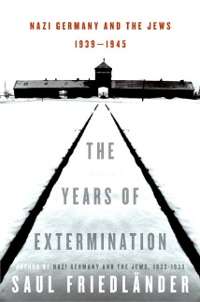The Years of Extermination
The Years of Extermination: Nazi Germany and the Jews, 1939–1945 is the second volume of Saul Friedländer's history of Nazi Germany and the Jews. It describes the German extermination policies that resulted in the murder of six million European Jews. The book presents a detailed history of the Holocaust and is based on a vast array of documents and memoirs. It won the 2007 Leipzig Book Fair Prize for Non-fiction and won the Pulitzer Prize for General Non-Fiction in 2008.[1]
 | |
| Author | Saul Friedländer |
|---|---|
| Publisher | HarperCollins |
Publication date | April 10, 2007 |
| Media type | Hardback |
| Pages | 896 |
| ISBN | 0-06-019043-4 |
| OCLC | 70660369 |
Historian Richard J. Evans, writing in The New York Times said that, though written with academic rigor, "what raises The Years of Extermination to the level of literature, however, is the skilled interweaving of individual testimony with the broader depiction of events."[2]
Friedländer is an Intentionalist on the origins of the Holocaust question. However, Friedländer rejects the extreme Intentionalist view that Adolf Hitler had a master plan going back to the time when he wrote Mein Kampf for the genocide of the Jewish people. Friedländer, through his research on the Third Reich, has reached the conclusion that there was no intention to exterminate the Jews of Europe before 1941. Friedländer's position might best be deemed moderate Intentionalist.
See also
References
- The Years of Extermination
- Richard J. Evans (June 24, 2007). "Whose Orders?". The New York Times.